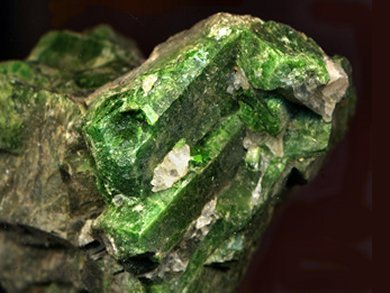Diopside has the composition CaMgSi2O6 and forms monoclinic prismatic crystals of the space group C2/c, but they are somewhat rare. More often granular and globular structures are found.
The name comes from the Greek dis for twice and opsis for face and refers to the fact that the crystals are often twinned. J. B. d’Andrada first described the mineral in 1800. It was then called Coccolit. Diopside is classified as belonging to the subgroup of chain and band silicates with 2-periodic single chains Si2O6/pyroxene. Diopside is a rock-forming mineral that occurs worldwide in alkaline and ultraalkaline rocks, and has also been detected in lunar rocks.
In chrome diopside, a small proportion (up to 2 %) of the Mg2+ ions in the octahedral sites are replaced by Cr3+ ions. The CrO6 chromophores are responsible for the emerald color of the mineral. As the chromium ions have a higher charge than the magnesium ions, an accompanying exchange of either calcium with sodium or silicon with aluminum is necessary to balance the charge.
Chrome diopside is commonly found in olivine and often found close to diamond deposits in South Africa. Also, high-pressure mixed crystals that contain 40 % NaCrSi2O6 have been found in the diamond mines of Yakutia.
Diopside and chrome diopside have no great economic impact other than their use as stones in jewelry.
The chrome diopside pictured above was foundin Outokumpo, Finland.
Picture © Ekkehard Diemann, University of Bielefeld, Germany,
Chrome Diopside is the answer to Guess the Mineral (1).
The next mineral quiz was published in early June.
The lucky winners are I. Abramova, USA, and C. Escudero, Spain.




